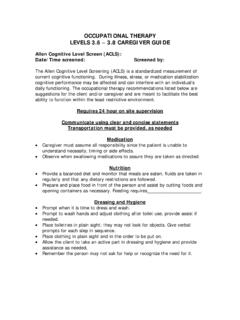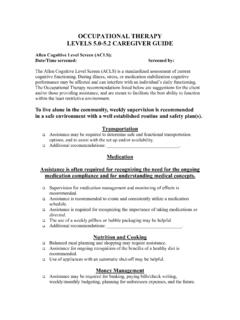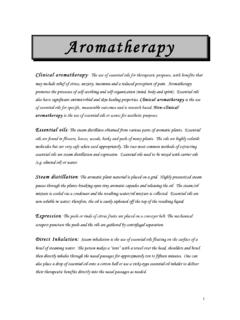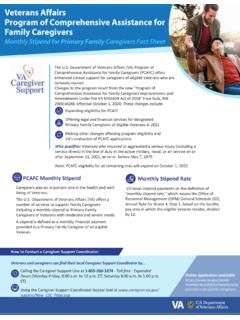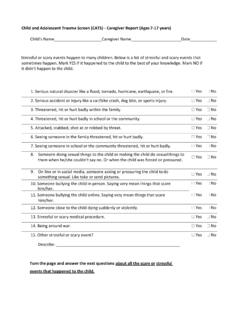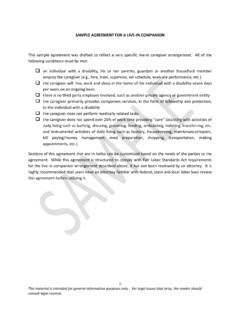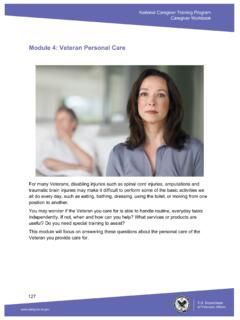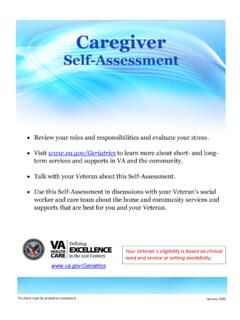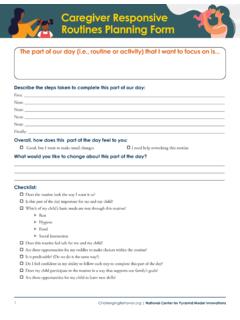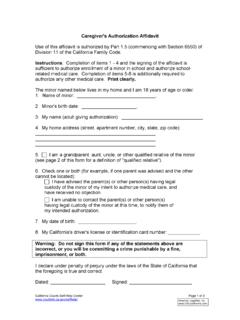Transcription of OCCUPATIONAL THERAPY LEVELS 3.0 – 3.4 CAREGIVER GUIDE
1 OCCUPATIONAL THERAPY . LEVELS CAREGIVER GUIDE . Allen Cognitive Level Screen (ACLS): Date/Time screened: Screened by: The Allen Cognitive Level Screening (ACLS) is a standardized measurement of current cognitive functioning. During illness, stress, or medication stabilization cognitive performance may be affected and can interfere with an individual's daily functioning. The OCCUPATIONAL THERAPY recommendations listed below are suggestions for the CAREGIVER and are meant to facilitate the best ability to function within the least restrictive environment. Requires 24 hour on site supervision A consistent environment and routine are recommended. Communicate using clear and concise statements Medication Caretaker must assume all responsibility since the patient is unable to understand necessity, timing or side effects.
2 Observe client when swallowing medications to assure they are taken as directed. Eating Provide a balanced diet and monitor for compliance with any dietary restrictions. Use verbal cues to prompt to continue eating when necessary. Prepare and place food in front of the client and assist by cutting foods and opening containers as necessary. Feeding requires_____. Prevent burns by monitoring the temperatures of drinks within arm's reach. Prevent spills by partially filling cup or using a lid/straw. Remove small non-edible items from arm's reach. Dressing and Hygiene Prompt and assist as needed when it is time to dress and wash, use of a seated position may reduce the risk of falls. Place clothing in plain sight and in the order to be put on with assistance provided as needed.
3 Prompt or assist if putting clothes on inside out or backwards. Prompt or assist to wash hands and adjust clothing after toilet use. Place toiletries in plain sight and use verbal/hand-over-hand prompts for each step. Allow the client to take an active part in dressing and hygiene if possible providing physical assistance as needed. Toilet Use Assist and cue to use toilet every two hours, and 30 minutes after meals. Personal hygiene requires assistance. Safety recommendations A safe environment and close monitoring is needed. Place name on door of bedroom, particularly when in new environments. Barricade open stairwells & install gates, especially at night. Intercom systems, night-lights, security doors or locks may prevent wandering and/or getting lost. Leave bed side-rails down to prevent climbing over.
4 A tub bench or seat, grab bars and a hand-held shower often help to prevent falls. Monitor temperature of water to avoid scalding & assist in and out of shower. Remove unsteady furniture patient may grab onto for support, small rugs, and objects on floor, especially in the bathroom. Lock away medications and toxic chemicals or keep out of reach. Supervise closely when near the stove (may touch a hot burner). Mobility and Positioning Recommend active &/or passive range of motion exercises one or more times per day, to prevent muscle weakness, contractures and/or loss of range. Remind and assist with all use of any equipment required for safe ambulation: walker, cane-as often as necessary. Proper positioning often improves posture, cognition and helps to prevent sores. Use a lap tray or seat cushions/wedges to position correctly & prevent slipping or slouching as appropriate.
5 For transfer safety and awareness: use a count of three, verbal and physical cues. Activities Encourage engagement in an activity to prevent sitting for extended periods. Set the person up with repetitive tasks (polishing, sanding, folding). Place objects directly in front of the person. Provide limited choices and fully set up the activity. Demonstrate each step and provide cues to keep going . Provide a place to sit and watch the activities of others. Provide a calm environment: consider lighting, sound, amounts and types of stimulation. Encourage movement (e. g., routine walks, simple stretches as appropriate). It is important to determine the types and amounts of stimulation the person is able to tolerate at different times of the day and to prevent sensory deprivation.
6 O Refer to enclosed sensory diet form for additional recommendations. Reference Allen, , Blue, T., & Earhart, C. (1995). Understanding Cognitive Performance Modes. Ormond, Florida: Allen Conferences. Compiled by: Tina Champagne , OTR/L Allen Authorized Advisor ~ 12/2003 rev

